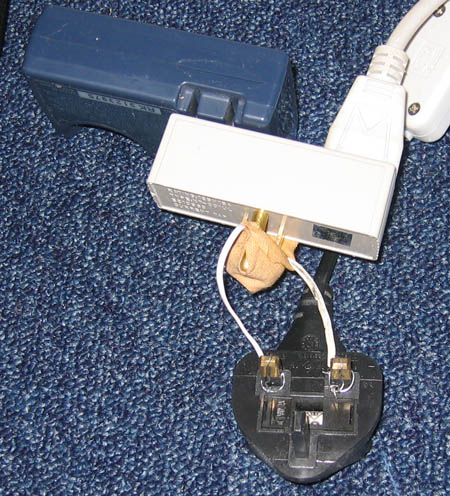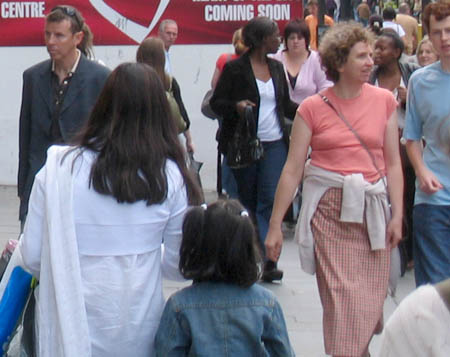|
|
|
tourists in Glasgow
Thursday, August 2 2007
setting: Mclays Guest House, Garnet Hill, Glasgow, Scotland, UK
Though the camera had been acting flaky, we'd managed to find free WiFi in our room from some unprotected wireless hub nearby. I'd brought the wrong sort of wall adapter and had been forced to jury-rig my own adapter using a couple steel twisty-ties as electrical wires. I'd connected these to the pins of a conventional one-to-three US-style powerstrip and then made little loops to slip around the prongs of a big UK-style plug (on whatever device was in the room). But because these prongs are insulated at their bases, I had to add little stirrups of wire to fold over the prongs' tips so I could gain access to the 240 volts when I plugged the assemblage into the wall. (Unlike during our trip to South Africa, all my electrical equipment can function with either 120 or 240 volts and all I have to worry about is a physical connection.) I'd actually had hopes of rigging up a somewhat more robust power system using a scrap power cord from the street, but Glasgow is an absurdly-clean city and I'd had a hard enough time finding twisty-ties, let alone abandoned electrical devices.

Notice that I used a bandaid for electrical tape to make this contraption slightly less dangerous.
We spent the day doing mostly hum-drum touristy stuff in downtown Glasgow. We went to the Art Noveau Charles Rennie Mackintosh-designed Willow Tea Room for breakfast. It was strange setting for a restaurant, since the main dining area was restricted to the balconies of an upstairs with a clear view down into a tacky jewelry store (is there any other kind?), with unobstructed views past abstract floral iron railings down into the cobweb-filled mechanisms that rotate displays of glistening diamonds just like on the Gem Shopping Network.
Later we wandered through George Square into an ornate public building whose interior had been thickly encrusted in a marble. At the
Gallery of Modern Art, we eventually found our way to a massive exhibit whose goal was to address the issue of partisanship in Glasgow. Evidently this is a huge issue, with constant tension between Catholics and Protestants, much of which is manifested in football rivalries. Glasgow, you see, has a large population of Irish Catholics and they tend to support a team called the Celtics, whereas the largely non-Irish Protestant majority supports a team called the Rangers. It's an extension of the strife present in Northern Ireland, which isn't far too the southwest across the sea. The exhibit showed dueling movie clips from flute bands on either side of the divide, as well as family trees showing the interconnectedness of various people (all of whom had Irish and English in their family trees, as well as the occasional Norwegian). It was hard for us to get our brains around the intensity of feeling bubbling out of (and reacting against) the rivalry, but the display had caused many to leave emotionally cathartic messages on the comment board. Gretchen talked to one of the museum employees at some length about the rivalry. Interestingly, the guy had clearly been drinking alcohol. It was early afternoon so perhaps he wasn't out of line.
We wandered down to the banks of the River Clyde, the only place we'd yet been to in the city that wasn't spotlessly tidy. On the concrete retaining walls was a fair amount of graffiti and nearby were various discarded bits of trash. A couple of young men were drinking beer on a park bench with a gentleman roughly twice their age. There was also some alcohol-augmented merriment happening between a some squirly-looking men and a slightly less-squirly-looking woman. I got the feeling that the riverside was a de facto lawless zone for the city. Every city needs a few of these in order to function effectively and successfully compete against others.
On the north bank of the Clyde near the east end of town there is a largish public park called the Glasgow Green, purportedly the place James Watt was strolling where he first got the idea for his steam engine. For better or worse, this is ground zero for the Industrial Age. In the park are a number of monuments and buildings. One of the former is an unintentionally comic celebration of the breadth of the British Empire, with deep reliefs of white people in triumph among exotic animals representing Australia, South Africa, Canada, and India. The biggest building of all is the People's Palace, much of which consists of a massive greenhouse filled with tropical plants. I had a coffee in the courtyard but it was too late in the day for food such as chips. At some point we wandered into the other part of the People's Palace and found it an unexpectedly informative museum of Glasgow's 19th and 20th century social history. Most of the heroes of that history had been labor organizers and socialists, whom the museum documented with the sort of loving nostalgia that would be impossible in a government-funded American museum.
For a second night in a row, we found ourselves dining at the 13th Note. This time I ordered their spicy chips, which cost ten pence more per serving than the regular ones. The difference being paid for was spices: rosemary, thyme, paprika, black pepper, and perhaps others. They spoke "chip" with a distinctly Indian lilt, and they were delicious. We'd be craving them for the rest of our time in Scotland.

There are some people of African origin in Glasgow, but not many.
See more photographs from the Scotland trip.
For linking purposes this article's URL is:
http://asecular.com/blog.php?070802 feedback
previous | next |

